Pancreatic/Colorectal Adenocarcinoma Rates Have Increased in Young Adults
Although the overall incidence of colorectal adenocarcinoma is decreasing, the reduction is primarily associated with patients 55 years or older.
The highest annual percentage change in pancreatic adenocarcinoma was observed in patients aged 15 to 34 years and was significantly higher than in patients 55 years or older or patients aged 35 to 54 years.

The incidence of pancreatic and colorectal adenocarcinoma has increased among young adults, highlighting a need for heightened awareness of this trend when evaluating younger patients with possible symptoms, according to findings from a retrospective cohort study published in JAMA Network Open.1
Findings from the trial revealed that a total of 275,273 patients with pancreatic adenocarcinoma were reported between 2000 and 2021, 51.8% of whom were male and 87.1% of whom were 55 years or older. An overall increasing incidence trend was noted, with the highest annual percentage change (APC) observed in those aged 15 to 34 years (4.35%; 95% CI, 2.03%-6.73%). The APC for the aforementioned age group was significantly higher than in those 55 years or older (1.74%; 95% CI, 1.59%-1.89%; P = .007) and those aged 35 to 54 years (1.54%; 95% CI, 1.18%-1.90%; P = .004).
Additionally, the study identified 1,215,200 patients with colorectal adenocarcinoma between 2000 and 2021, 52.8% of whom were male and 80.4% of whom were 55 years or older. Although an overall decreasing trend was noted across all patient subgroups, the APC was positive for patients aged 15 to 34 years (1.75%; 95% CI, 1.08%-2.42%; P = .001) and those aged 35 to 54 years (0.78%; 95% CI, 0.51%-1.06%; P = .002); it was –3.31% (95% CI, –3.54% to –3.08%) in those 55 years or older.
“Clinicians should be aware of this trend in younger age groups so their suspicion is higher when patients present with symptoms,” senior author Arvind Trindade, MD, chief of endoscopy at Robert Wood Johnson University Hospital and director of endoscopic research at Robert Wood Johnson Medical School, stated in a news release on the study.2 “Pancreatic cancer has traditionally been viewed [as] a disease seen in older patients. However, this trend suggests the need for higher vigilance among providers when a younger patient is experiencing abdominal pain with other concerning symptoms that could indicate a more serious condition.”
Investigators of the cohort study attained pancreatic and colorectal adenocarcinoma incidence rates per 100,000 population from 2000 to 2021 from the Surveillance, Epidemiology, and End Results (SEER) database. The SEER database collects and publishes cancer incidence, prevalence, and mortality data from population-based registries covering approximately 47.9% of the US population, with data through 2021 released April 17, 2024.
Patients in the trial with pancreatic cancer were predominantly White (81.83%) followed by Black (12.33%). A total of 12.28% and 0.59% of patients were aged 35 to 54 years and 15 to 34 years, respectively. Furthermore, those in the trial with colorectal cancer were also predominantly White (81.07%) followed by Black (12.18%). Patients aged 15 to 34 years accounted for 1.14% of colorectal cases, and those aged 35 to 54 years accounted for 18.48%.
Of note, in pancreatic adenocarcinoma, the APC was higher for male patients (1.87%; 95% CI, 1.63%-2.11%) than for female patients (1.57%; 95% CI, 1.27%-1.87%) but did not reach statistical significance (P = .13). Dissimilarly, the APC for male patients with colorectal adenocarcinoma (–2.70%; 95% CI, –2.91% to –2.48%) decreased at a greater rate than for female patients (–2.59%; 95% CI, –2.84% to –2.34%) but was not statistically significant (P = .13).
Although the APCs increased across all racial groups for pancreatic adenocarcinoma, patients who identified as American Indian or Alaska Native experienced the highest APC of 1.96% (95% CI, 1.09%-2.83%) vs 1.90% (95% CI, 1.80%-2.00%) in those who identified as White, who experienced the next highest APC increase (P = .32). Furthermore, the American Indian or Alaska Native group experienced the lowest decrease in APC for colorectal adenocarcinoma at –1.56% (95% CI, –2.04% to –1.07%) vs –2.71% (95% CI, –2.95% to –2.47%) in patients who identified as Asian or Pacific Islander, who experienced the next lowest APC decrease (P = .001).
References
- Bussetty A, Shen J, Benias PC, Ma M, Stewart M, Trindade AJ. Incidence of pancreas and colorectal adenocarcinoma in the US. JAMA Netw Open. 2025;8(4):e254682. doi:10.1001/jamanetworkopen.2025.4682
- Robert Wood Johnson University Hospital and Rutgers Health study shows that colorectal and pancreatic adenocarcinoma incidence rates are rising most among young adults. News release. RWJ Barnabas Health. April 14, 2025. Accessed April 15, 2025. https://tinyurl.com/mehb3nxk
Newsletter
Stay up to date on recent advances in the multidisciplinary approach to cancer.